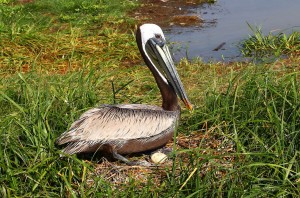Flexibility of cormorant and pelican diet assemblages
Red knot resight data indicates flux between two migration staging areas
September 4, 2009Azalea Continues Her Wanderings
September 6, 2009
Written by Adam Duerr & Bryan Watts
September 5th, 2009

Many seabirds including the Southeastern population of brown pelicans depend on the Atlantic Coast for their entire life cycle. Photo by Bryan Watts.
Understanding the ecological role that birds play in the Chesapeake Bay has been a dominant theme for research conducted by The Center for Conservation Biology (CCB). In recent years, CCB has collaborated with researchers from the Virginia Commonwealth University and the University of Virginia on a NOAA-funded project to evaluate bird-fish interactions within the Bay with a focus on menhaden. During the 2009 breeding season, we investigated the diet of breeding double-crested cormorants and brown pelicans nesting within the main stem of the Bay.
During breeding season, adult cormorants and pelicans build their nests in colonies that contain a few dozen up to several thousand nests. After nestlings hatch, one adult leaves the colony to find fish, while the other remains at the nest with the young birds. Upon returning to the nest, the adult regurgitates fish directly into the mouths of its nestlings. When we visit the colonies, nestlings respond to us by regurgitating any fish in their crops. This allows us to identify, count, and estimate the size of the fish that are consumed by each species. To limit our disturbance at colonies, we only visited colonies 2-3 times during the summer, with visits separated by 1-2 weeks.

VCU fish ecologists Steve McIninch and Dave Hopler identify fish within the Smith Island colony with the Center for Conservation Biology waterbird ecologist Adam Duerr. Photo by Bryan Watts.

A menhaden in a brown pelican’s nest. Photo by Bryan Watts.
By weight, double-crested cormorants and brown pelicans consumed mostly Atlantic menhaden. Atlantic menhaden made up 50-55% of the diet of cormorants and 74% of the diet of brown pelicans. This finding confirms that menhaden, which are very important prey for osprey, are also very important for these waterbirds. Other important fish for cormorants were Spot (8-27% of diet) and Atlantic croaker (13-16% of diet). For brown pelicans, bay anchovies were also important (14% of their diet).
Our findings show that waterbird diets are often flexible and reflect fish assemblages in local waters. In 2008, we found that double-crested cormorants consumed mostly gizzard shad and hogchoker along the James River near Hopewell, Virginia. While these species were also present in the diets of cormorants on Smith and Poplar Islands, they were much less important. These results are similar to those of graduate student Andy Glass, who showed that osprey diet shifts along a salinity gradient presumably due to changes in fish assemblages. The Chesapeake Bay populations of both brown pelicans and double-crested cormorants are growing suggesting that they are not experiencing significant food stress.
Project sponsored by The Center for Conservation Biology (CCB) and the National Oceanic and Atmospheric Administration (NOAA) Chesapeake Bay Program, Virginia Commonwealth University (VCU), the University of Virginia (UVa), and the Maryland Department of Natural Resources (MD DNR).



